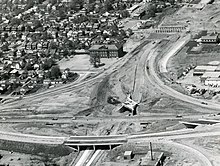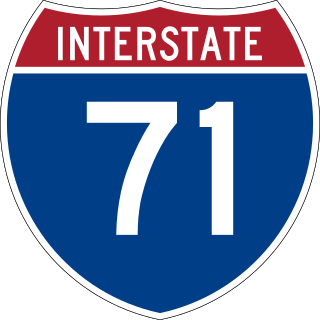
Interstate 71 (I-71) is a north–south Interstate Highway in the Midwestern and Southeastern regions of the United States. Its southern terminus is at an interchange with I-64 and I-65 in Louisville, Kentucky, and its northern terminus at an interchange with I-90 in Cleveland, Ohio. I-71 runs concurrently with I-75 from a point about 20 miles (32 km) south of Cincinnati, Ohio, into Downtown Cincinnati. While most odd numbered Interstates run north–south, I-71 takes more of a northeast–southwest course, with some east–west sections, and is mainly a regional route serving Kentucky and Ohio. It links I-80 and I-90 to I-70, and ultimately links to I-40. Major metropolitan areas served by I-71 include Louisville, Cincinnati, Columbus, and Cleveland.
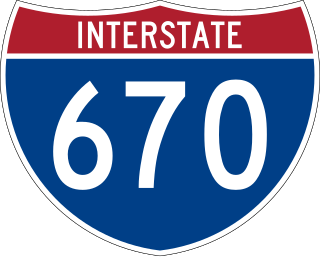
Interstate 670 (I-670) is an Interstate Highway in the US state of Ohio that passes through Columbus connecting I-70 west of Downtown Columbus with I-270 and U.S. Route 62 (US 62) near the eastern suburb of Gahanna. I-670 provides access to John Glenn Columbus International Airport and intersects State Route 315 (SR 315) and I-71 downtown. The section between SR 315 and I-71 is commonly referred to by locals as the "North Innerbelt"; the rest of the Innerbelt consists of SR 315 (west), I-70 (south), and I-71.
An innerbelt or outerbelt is a ring road or collection of roadways which is or implies that it is inner or outer ring road in relation to another ring road. Use of these terms is most common and near-exclusive to routes in the United States, mostly in the state of Ohio.
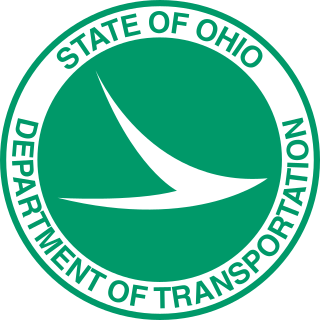
The Ohio Department of Transportation is the administrative department of the Ohio state government responsible for developing and maintaining all state and U.S. roadways outside of municipalities and all Interstates except the Ohio Turnpike. In addition to highways, the department also helps develop public transportation and public aviation programs. ODOT is headquartered in Columbus, Ohio. Formerly, under the direction of Michael Massa, ODOT initiated a series of interstate-based Travel Information Centers, which were later transferred to local sectors. The Director of Transportation is part of the Governor's Cabinet.

Olde Towne East is a neighborhood located in the historical Near East Side of Columbus, Ohio and is one of Columbus' oldest neighborhoods. The area has over 1,000 homes, some as old as the 1830s, and more than 50 architectural styles as a result of its history. These homes were built by many of the famous individuals of Columbus including industrialists, lawyers, judges, teachers, architects, mayors, governors, and legislators, many of whom shaped the city.
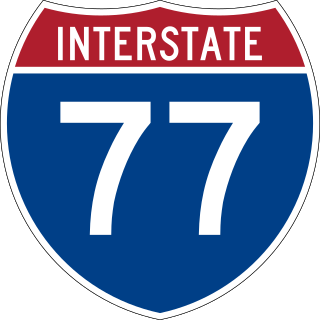
Interstate 77 (I-77) in Ohio is an Interstate Highway that runs for 163.03 miles (262.37 km) through the state. The highway crosses into Ohio on the Marietta–Williamstown Interstate Bridge over the Ohio River near Marietta. The northern terminus is in Cleveland at the junction with I-90. From the West Virginia state line to Cleveland, I-77 serves the cities of Marietta, Cambridge, New Philadelphia, Canton, Akron, and the Cleveland suburban city of Brecksville.

Interstate 75 (I-75) runs from Cincinnati to Toledo by way of Dayton in the US state of Ohio. The highway enters the state running concurrently with I-71 from Kentucky on the Brent Spence Bridge over the Ohio River and into the Bluegrass region. I-75 continues along the Mill Creek Expressway northward to the Butler County line just north of I-275. From there, the freeway runs into the Miami Valley and then passes through the Great Black Swamp before crossing into Michigan.
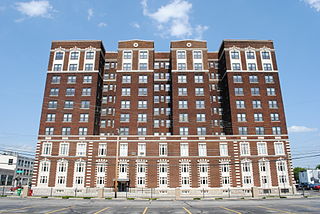
The Seneca, formerly known as the Seneca Hotel, is a 10-story apartment complex and former hotel in the Discovery District of downtown Columbus, Ohio. The brick building was designed by architects Frank Packard and David Riebel & Sons and built in 1917, in a prominent location near Franklin County Memorial Hall, where conventions were held. A four-story wing was built on the hotel's east side in 1924. The hotel closed in the mid-20th century, and it held the Nationwide Beauty Academy from 1960 to 1974. Dormitories held female students for Nationwide and about six other public and private schools downtown. The Seneca became home to the Ohio Environmental Protection Agency from 1976 to 1987. The building was added to the National Register of Historic Places in 1983 and the Columbus Register of Historic Properties in 1991. In 1988, the building became vacant, and remained that way until 2005.
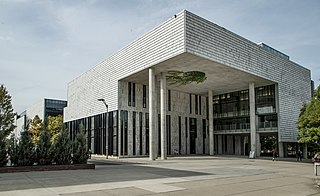
The architecture of Columbus, Ohio is represented by numerous notable architects' works, individually notable buildings, and a wide range of styles. Yost & Packard, the most prolific architects for much of the city's history, gave the city much of its eclectic and playful designs at a time when architecture tended to be busy and vibrant.

The Charles S. Barrett Building is a historic building in the Merion Village neighborhood of Columbus, Ohio. It was listed on the Columbus Register of Historic Properties in 2006 and the National Register of Historic Places in 2015. The building was completed in 1900 as the home of the city's South High School, part of the Columbus Public School District. It has since been converted into apartments, rented out as The Barrett.

The Felton School was a public school building in the Mount Vernon neighborhood of Columbus, Ohio, and a part of the Columbus Public School District. It was listed on the National Register of Historic Places in 1984 and the Columbus Register of Historic Properties in 1985.

The Hartman Hotel is an condominium complex and former hotel and office building in Downtown Columbus, Ohio. The building was completed in 1898 and was listed on the National Register of Historic Places in 2018.

David Riebel was a German-American architect in Columbus, Ohio. He was the head architect for the Columbus public school district from 1893 to 1922. In 1915, The Ohio Architect, Engineer and Builder considered his firm, David Riebel & Sons, to be the oldest and among the best architects in Columbus.
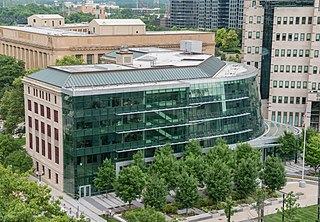
77 North Front Street is a municipal office building of Columbus, Ohio, in the city's downtown Civic Center. The building, originally built as the Central Police Station in 1930, operated in that function until 1991. After about two decades of vacancy, the structure was renovated for city agency use in 2011.

The Neville Mansion is a historic house in the Olde Towne East neighborhood of Columbus, Ohio. Portions of the house may have been built in the early 19th century, though the majority was complete by the mid-1850s. It was built for M.L. Neville, who purchased the property in 1855. Two years later, it became the Ohio Asylum for the Education of Idiotic and Imbecile Youth, which moved out to its current campus in 1868. The mansion then held the Hannah Neil Mission and Home of the Friendless for over a century, from 1868 to 1977. The mission served as an orphanage, homeless shelter, and school for various types of disadvantaged residents throughout its history. After Neil's organization moved out, the mansion was renovated for office use.

Southwood Elementary School is a public elementary school in Columbus, Ohio, part of Columbus City Schools. The school building, located in the city's Merion Village neighborhood, was completed in 1894 and was designed by David Riebel. It was added to the Columbus Register of Historic Properties in 2002.

120 S. Central Avenue is a former school building in the Franklinton neighborhood of Columbus, Ohio. The building was built for the West High School, and later served as Starling Middle School and Starling Elementary School. The building was added to the National Register of Historic Places and Columbus Register of Historic Properties in 2022.
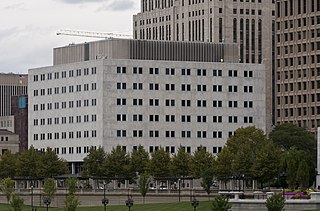
25 South Front Street and 145 South Front Street are a pair of office buildings in Downtown Columbus, Ohio. The structures, built for state offices in the 1960s, are situated immediately north and south of the Ohio Judicial Center. The Ohio Department of Education occupies 25 South Front. 145 South Front Street has been vacant since 2006, though plans to create a mixed-use development in the building were announced in 2022.
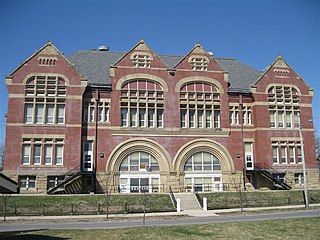
Medary Avenue Elementary School is a school building in the Old North Columbus neighborhood of Columbus, Ohio. The building was constructed in 1892 and was designed by prolific school architect David Riebel.

Beck Street School is a school building in the Schumacher Place neighborhood of Columbus, Ohio. The building was constructed in 1884 and was designed by prolific school architect David Riebel. The school was recognized as one of Columbus's historically significant schools, in a 2002 report by the Columbus Landmarks Foundation.



